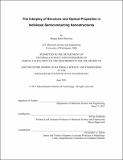The interplay of structure and optical properties in individual semiconducting nanostructures
Author(s)
Brewster, Megan Marie
DownloadFull printable version (13.25Mb)
Other Contributors
Massachusetts Institute of Technology. Dept. of Materials Science and Engineering.
Advisor
Silvija Gradečak.
Terms of use
Metadata
Show full item recordAbstract
Semiconductor nanostructures exhibit distinct properties by virtue of nano-scale dimensionality, allowing for investigations of fundamental physics and the improvement of optoelectronic devices. Nanoscale morphological variations can drastically affect overall nanostructure properties because the investigation of nanostructure assemblies convolves nanoscale fluctuations to produce an averaged result. The investigation of individual nanostructures is thus paramount to a comprehensive analysis of nanomaterials. This thesis focuses on the study of individual GaAs, AlGaAs, and ZnO nanostructures to understand the influence of morphology on properties at the nanoscale. First, the diameter-dependent exciton-phonon coupling strengths of individual GaAs and AlGaAs nanowires were investigated by resonant micro-Raman spectroscopy near their direct bandgaps. The one-dimensional nanowire architecture was found to affect exciton lifetimes through an increase in surface state population relative to volume, resulting in Fröhlich coupling strengths stronger than any previously observed. Next, ZnO nanowire growth kinetics and mechanisms were found to evolve by altering precursor concentrations. The cathodoluminescence of nanowires grown by reaction-limited kinetics were quenched at the nanowire tips, likely due to point defects associated with the high Zn supersaturation required for reaction-limited growth. Further, cathodoluminescence was quenched in the vicinity of Au nanoparticles, which were found on nanowire sidewalls due to the transition in growth mechanism, caused by excited electron transfer from the ZnO conduction band to the Au Fermi level. Finally, ZnO nanowalls were grown by significantly increasing precursor flux and diffusion lengths over that of the ZnO nanowire growth. Nanowall growth began with the Au-assisted nucleation of nanowires, whose growth kinetics was a combination of Gibbs- Thomson-limited and diffusion-limited, followed by the domination of non-assisted film growth to form nanowalls. Nanoscale morphological variations, such as thickness variations and the presence of dislocations and Au nanoparticles, were directly correlated with nanoscale variations in optical properties. These investigations prove unequivocally that nanoscale morphological variations have profound consequences on optical properties on the nanoscale. Studies of individual nano-objects are therefore prerequisite to fully understanding, and eventually employing, these promising nanostructures.
Description
Thesis (Ph. D.)--Massachusetts Institute of Technology, Dept. of Materials Science and Engineering, 2011. This electronic version was submitted by the student author. The certified thesis is available in the Institute Archives and Special Collections. Cataloged from PDF version of thesis. Vita. Includes bibliographical references (p. 163-174).
Date issued
2011Department
Massachusetts Institute of Technology. Department of Materials Science and EngineeringPublisher
Massachusetts Institute of Technology
Keywords
Materials Science and Engineering.